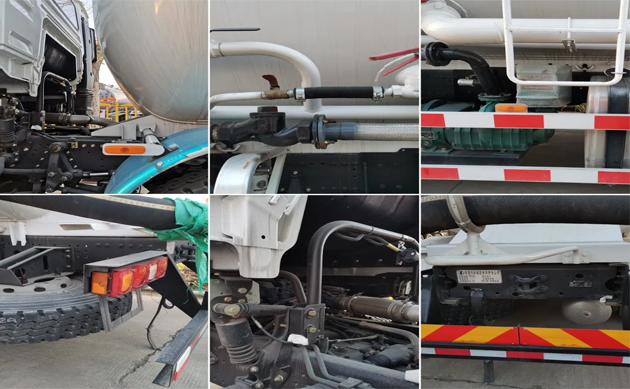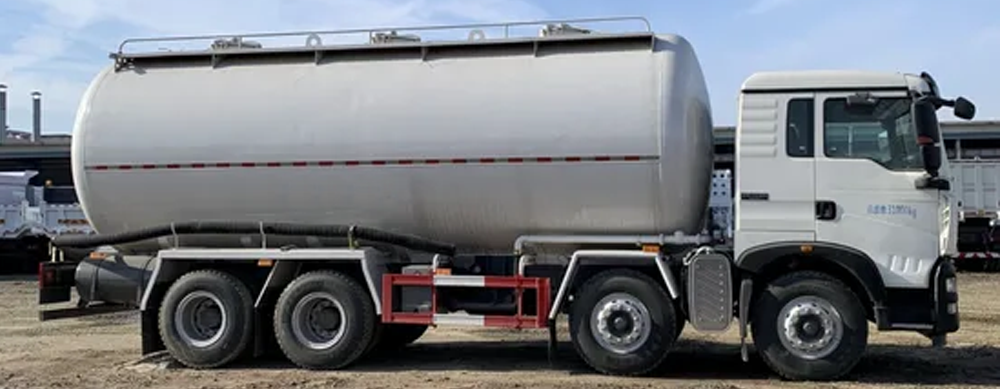Bulk Cement Trucks are essential vehicles in the construction and building materials industries, designed to transport and discharge cement efficiently. These trucks feature a robust, cylindrical tank made of high-strength steel, which not only ensures durability to withstand the weight of the cement but also provides excellent protection against corrosion. The tank is carefully engineered with a conical bottom to facilitate complete discharge of the cement, minimizing residue.
Equipped with a powerful pneumatic system, these trucks can unload the cement with great precision. Compressed air is used to fluidize the cement, allowing it to flow smoothly through the discharge pipes. The discharge mechanism is highly controllable, enabling operators to direct the cement exactly where it's needed, be it a storage silo or a specific construction site area.
| The Specifications of 6X4 Sinotruk HOWO 30CBM Bulk cement truck | ||
| Cabin | Driving type 6x4 LHD/RHD | |
| HW76 Lengthen cab, single bunk, safety belts, left hand driving, air conditioner. | ||
| Overall Dimensions | 9182X2496X3215, 3800 mm | |
| Wheel Base | 4600+1350 mm | |
| GVW | 25000kg | |
| Front axle loading capacity | 9000kg | |
| Rear axles loading capacity | 2 x 16000 | |
| Engine | Brand | Sinotruk |
| Model | WD615.47 | |
| Type | 6-cylinder in line, 4-stroke, water-cooled, turbo-charged & inter-cooled, direct injection | |
| Displacement | 9.726L | |
| Bore x Stroke | 126x130mm | |
| Horse Power (HP) | 371 | |
| Emission standard | Euro II | |
| Max Speed | 102 km/h | |
| Transmission | HW19710 transmission, 10 forward & 2 reverse, with PTO | |
| Steering | ZF8098 | |
| Oil Tank | 300L | |
| Tank Volume | 30CBM | |
| Brake System | Service brake: dual circuit compressed air brake | |
| Parking brake (emergency brake): spring energy, compressed air operating on rear wheels | ||
| Auxiliary brake: engine exhaust valve brake | ||
| Electrics | Operating voltage: 24V, negative grounded | |
| Batteries: 2x12 V, 165 Ah | ||
| horn, headlamps, fog lights, brake lights, indicators and reverse light | ||
| Option | Vertical Muffler, ABS, Automatic Break Clearance Adjusting Arm, Traveling Data Recorder, Metal Pipeline, Engine Protective Board | |

1. The chassis of a bulk cement truck is the backbone of the vehicle. It's typically a heavy-duty truck chassis made of high-strength steel. The chassis provides the structural support needed to carry the weight of the cement tank and the loaded cement.
2. The cement tank is the most distinctive component of a bulk cement truck. It's usually a large, cylindrical tank made of special-grade steel that can withstand the abrasive nature of cement.
3. A crucial part of the bulk cement truck is the pneumatic system. It's responsible for unloading the cement. The system consists of a compressor, air-storage tanks, pipes, and valves.
4. The discharge system includes the pipes and nozzles through which the cement is unloaded. The pipes are usually made of durable materials that can handle the abrasive cement flow.
5. The control system of a bulk cement truck allows the operator to manage the various functions of the vehicle. It includes controls for the pneumatic system, such as starting and stopping the compressor, adjusting the air pressure, and operating the valves.
6. The cab of a bulk cement truck is designed to provide a comfortable and safe environment for the operator. It has an ergonomic seat that reduces fatigue during long-haul trips.

1. Cement Capacity: Determine the volume of cement you need to transport regularly. Bulk cement trucks come with different tank capacities, usually ranging from a few cubic meters to over 30 cubic meters. Calculate your typical cement requirements based on your construction projects or delivery schedules.
2. Overall Dimensions: Consider the truck's size in terms of length, width, and height. Ensure that it can operate smoothly in the areas where you'll be using it.
3. Material and Construction: Look for a cement tank made of high-quality, corrosion-resistant steel. The tank's interior should have a proper lining to protect against the alkaline nature of cement. Check for the thickness and strength of the tank walls to ensure it can withstand the weight and abrasiveness of the cement over time.
4. Compressor Power: The pneumatic system's compressor is a key component. A more powerful compressor can generate higher air pressure, which is essential for fluidizing and unloading the cement quickly and efficiently.
5. Air-Storage Capacity: The air-storage tanks should have an adequate capacity to provide a continuous supply of compressed air during unloading.
6. Discharge Pipe Length and Flexibility: Consider the length and flexibility of the discharge pipes. Longer and more flexible pipes can reach different heights and distances, providing more versatility when unloading cement at construction sites.

Bulk cement trucks are equipped with sizable cement tanks, usually cylindrical in shape. These tanks are designed to hold significant volumes of cement, ranging from a few cubic meters to over 30 cubic meters.
A vital feature is the pneumatic unloading system. Compressed air is the driving force behind the unloading process. The system consists of a compressor, air-storage tanks, and a network of pipes.
The discharge system includes durable pipes and adjustable nozzles. The pipes, made of materials that can withstand the abrasive nature of the cement, are connected to the tank and lead to the outside of the truck.
The chassis of a bulk cement truck is heavy-duty and built to bear the weight of the full cement tank and its contents. It's paired with a reliable suspension system to provide a smooth ride and protect the tank and its components from vibrations and shocks during transportation.
These trucks feature control systems that are designed for ease of use. Operators can manage the pneumatic system, including starting and stopping the compressor, adjusting air pressure, and operating the valves through the control panel.
The operator's cab is designed with comfort in mind. It has an ergonomic seat to reduce operator fatigue during long-haul transportation and unloading operations.

